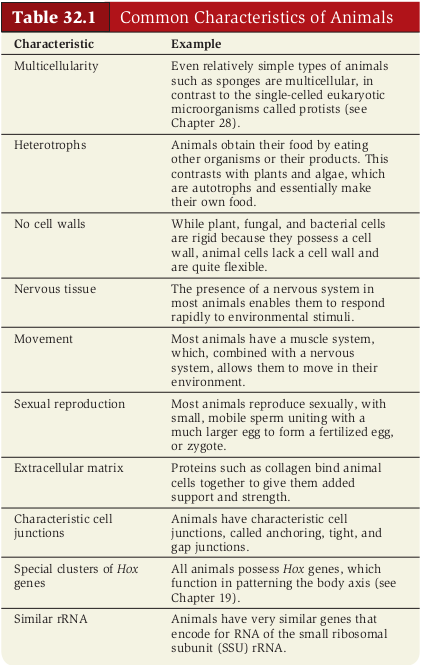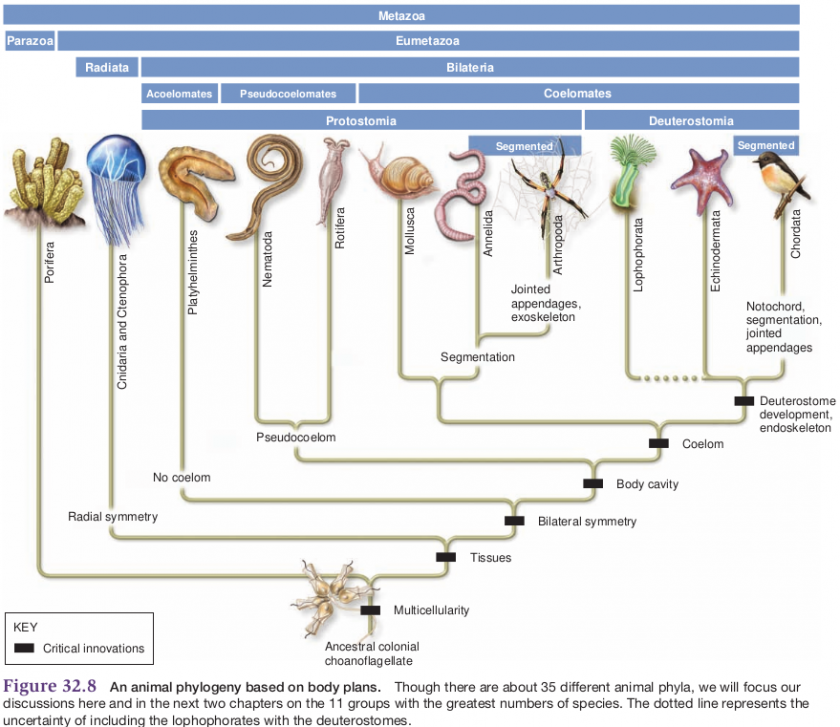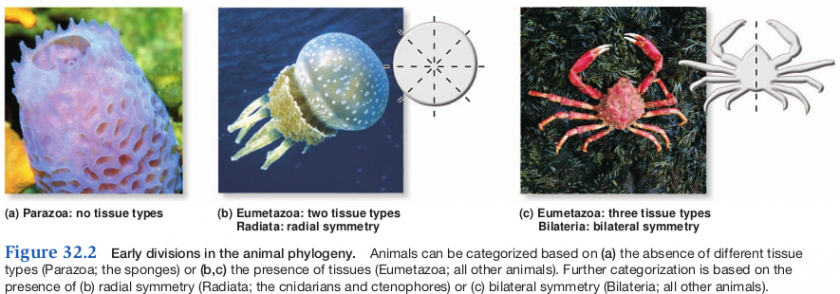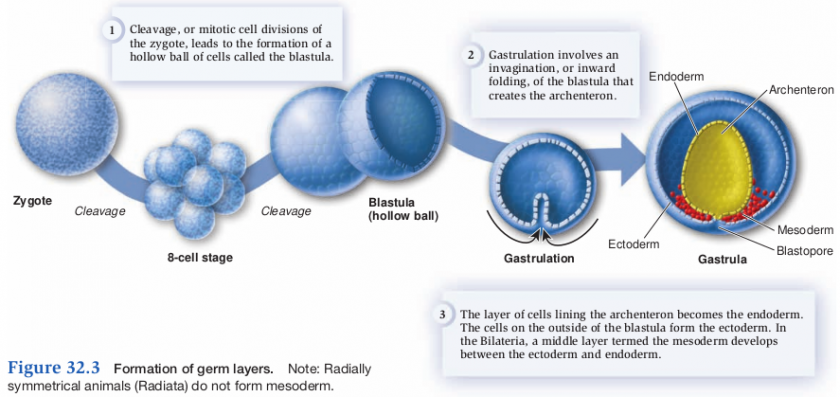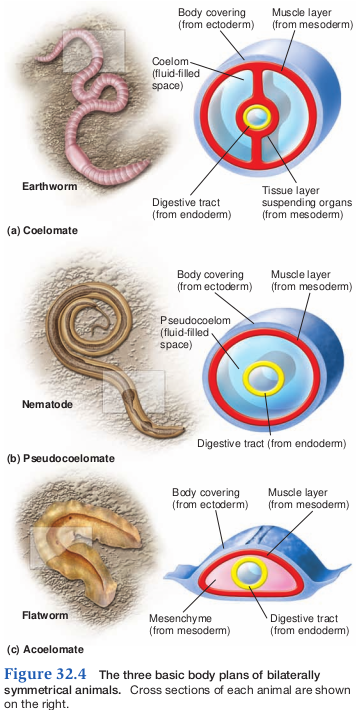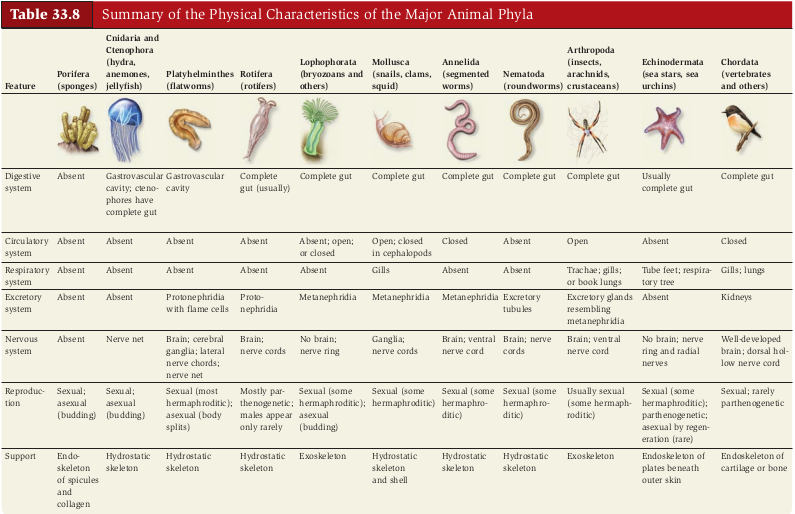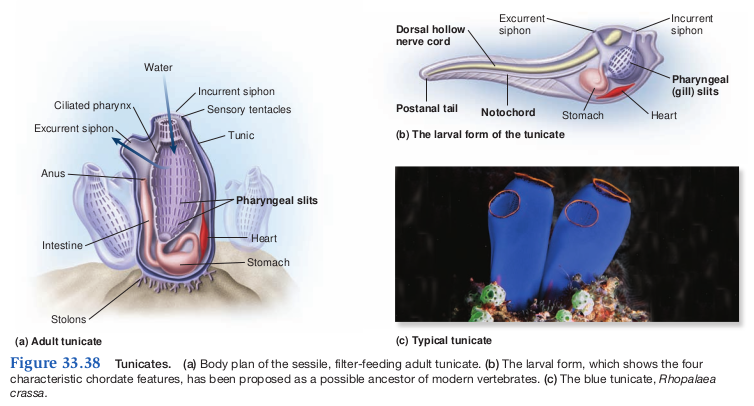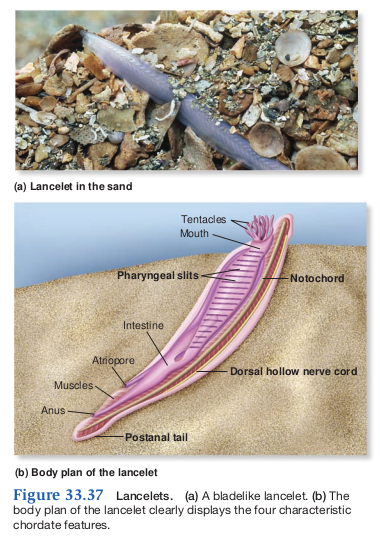Chapter 32 & 33
Kingdom Animilia
- Over 1.5 million species
- Estimated 73 million
- 35 Phylums
- Over half are insects
- More similarities within animal genomes than other kingdoms
Characteristics
- Multicellular
- Lack of cell wall
- Sexual reproduction
- mobile sperm
- larger non-motile egg
- Nervous Tissue
- Complexity
- Responsiveness
- Hox Genes
- Special clusters of genes associated with the planning of the body
Metazoans
- All animals
- Multicellular animals
- Paratoans
- Sponges
- Eumetazoans
- "true" multicellular animals
Classification/Systematics
- Old
- Morphology
- Embryonic Development
- Recent
- Molecular genetics
Body Plans
Morphological and Developmental Features
- Body Symmetry
- Number of tissue Layers
- Patterns of Embryonic development
Symmetry
- Eumetazoa
- Divided by symmetry
- Radiata
- Radial symmetry
- Often Circular or tubular
- Bilateria
- Bilateral symmetry
- Dorsal
- Back
- Ventral
- Front
- Anterior
- Posterior
- cephalization
- enlarged head
Tissues
- Metazoa
- all animals
- divided on weather or not they have specialized tissues
- Parazoa
- Porfera
- sponges
- may have distinct cell types
- Porfera
- Enmetazoa
- more than one type of tissue
- organs
- all other animals
Germ Layers
- Radial
- 2 layers
- Diploblastic
- endoderm
- ectoderm
- Bilateral
- 3 layers
- Triploblastic
- endoderm
- ectoderm
- mesoderm
Embryonic Development
- Protostome
- Blastopore becomes mouth
- cleavage is determinate
- fate of embryonic cells are determined early
- Deuterostome (second opening)
- Blastopore becomes anus
- cleavage is indeterminate
- each cell produced by early cleavage can develop into a complete embryo
Other Morphological Characteristics
Used in classification
- Presence or absence or coelom
- Body segmentation
Molecular data suggest these features are unreliable in terms of understanding evolutionary history
Body Cavity
Coelom
-
- a fluid-filled body cavity
- Coelomate or eucolemate
- true coelom
- coelom completely lined with mesoderm
- Pseudocoelom
- coelom only partially lined with mesoderm
- rotifers and roundworms
- Acoelomate
- lack of a body cavity and instead have mesenchyme
- flatworms
Flatworm has no mesoderm
Functions of the Coelom
- Cushions internal organs
- Enables movements and growth of internal organs independent of the body wall
- Fluid acts as a simple circulatory system
Segmentation
- Body may be divided into regions called segments
- occurs in annelid worms, arthropods, and chordates
- allows specialization of body region
DO NOT worry about the number of species
Molecular views of Animal Diversity
- Scientist now use molecular techniques to classify animals
- Compare similarities in DNA, rRNA, and Amino Acids
- Closely related organisms have fewer differences than those more distantly related
- Advantages over morphological data in that genetic sequences are easier to quantify and compare
- Example: A,T,G, and C in DNA
Genes used in Molecular Systematics
- Studies often focus on ribosomal RNA (rRNA)
- Universal in all organisms
- changes slowly over time
- Hox genes also studied often
- Found in all animals
- duplications in these genes may have led to evolution of body form
- Phylogenies constructed using rRNA and Hox genes are similar and often agree with those based on morphology
Invertebrates
- "without backbone"
- +95% of all species
Phylum Porifera
- Sponges
- lack tissues (organs)
- multicellular
- pores
- filter H2O and food
- Invertebrates
Phylum Cnidaria
- Jelly fish, corals, anemones
- Diploblastic development
- Two tissue layers
- Mesoclea
- gelatinous covering
- Nerve net
- interconnected nerve cells
- no brain
- One opening with gastrovascular cavity
- Protostomes
- Invertebrates
- Radial symmetry
- Salt and fresh water
- Stingers
Phylum Ctenophora
- Comb jellies
- Same characteristics as Cnidaria
- Strictly salt water
- No Stingers
Phylum Platyhelminthes
- Flatworms, tapeworms, flukes
- Triploblastic
- Organs and organ systems
- Enhanced nerve net
- 2 cerebral ganglia
- One opening with gastrovascular cavity
- Protostomes
- invertebrates
- bilateral symmetry
- Acoelomate
Phylum Rotifera
- rotifers
- pseudocoelomate
- Triploblastic
- Two openings
- complete gut tract
- alimentary canal
- Protostomes
- Corona
- simple brain
- invertebrates
Phylum Mollusea
- Snails, slugs, oysters, octopus, squid, clams, muscles
- Triploblastic
- Eucoelomate
- Complete gut tract
- Protostomes
- Invertebrates
- Three part Body
- Foot
- Visceral mass
- Mantle
- Many have outer shells
Phylum Annelida
- Segmented ring worms
- Triploblastic
- Eucoelomate
- Complete gut tract
- Protostomes
- Enhanced nervous system
- Invertebrates
Phylum Nematoda
- Roundworms
- Triploblastic
- Pseudocoelomate
- Complete gut tract
- Protostomes
- Invertebrates
Phylum Anthropoda
- Insects, crustaceans, spiders, ticks
- Highest diversity of animals
- >1.5 million species
- Hardened Exoskeleton
- Protostomes
- Invertebrates
- Eucoelomate
- Triploblastic
- Complete gut tract
- Enhanced nervous system
- Insects, in particular, have an enhanced brain
- segmented appendages
Phylum Echinodermata
- sea stars, urchins, sea cucumbers, sand dollars
- Triploblastic
- Eucoelomate
- Complete gut tract
- Deuterostomes
- Simple nervous system
- Endoskeleton
- series of plates
Phylum Chordata
- Deuterstomes
- Complete gut tract
- Endoskeleton
- Few invertebrates
- Mostly vertebrates
- Eucloemates
- Triploblastic
Four Critical Innovations of Chordate Body Design
- Notochord
- Dorsal, hollow nerve cord
- Pharyngeal gill pouches
- Post-anal tail
- These four features are exhibited at some point of life history/development
- Only some Fishes exhibit all four
Notochord
- Cartilaginous supporting rod along the dorsal axis
- Replaced by jointed "backbone"
- Vertebral column of hardened cartilage or bone
Dorsal, hollow nerve cord
- Expanded at the anterior end
- Brian
- Enclosed/supported/protected by the Notochord
Pharyngeal gill pouches
- Gill slits
- pharynx
- back of mouth cavity
Post-anal Tail
- Tail extends posterior of the anus
Humans
Notochord
- replaced by vertebrae
- only pieces left are the inter-vertebral discs between vertebrae
Nerve cord
- Dorsal, hollow with largest brain capacity (compared to body size)
Pharyngeal Pouches
- Embryonic Development
- 1 pair retained as Eustachian tubes
Post-anal Tail
- One vertebra as a tail bone (coccyx)
Subphylum Urochordata
- tunicates
- invertebrates
- ~3000 species
- Marine
- Filter feeders
Subphylum Cephalochordata
- Lancelets
- Invertebrates
- 25 species
- marine
- Filter feeders

